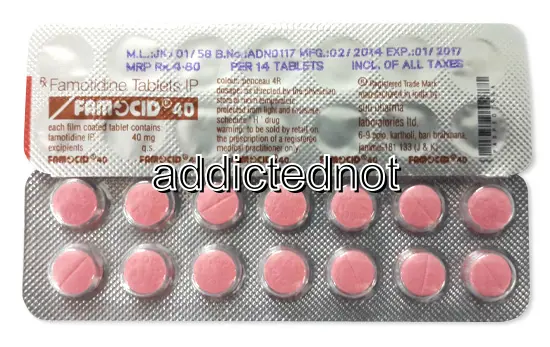| Package | Dosage | Price | Price per Dose | |
|---|---|---|---|---|
| Dosage: 20mg | ||||
| 336 pill | 20mg | $187.68 | $0.56 | |
| 224 pill | 20mg | $158.94 | $0.71 | |
| 168 pill | 20mg | $142.03 | $0.85 | |
| 112 pill | 20mg | $114.97 | $1.03 | |
| 84 pill | 20mg | $92.99 | $1.10 | |
| 56 pill | 20mg | $67.62 | $1.20 | |
| 28 pill | 20mg | $38.88 | $1.37 | |
| Dosage: 40mg | ||||
| 336 pill | 40mg | $216.43 | $0.64 | |
| 224 pill | 40mg | $170.77 | $0.76 | |
| 168 pill | 40mg | $142.03 | $0.85 | |
| 112 pill | 40mg | $109.90 | $0.98 | |
| 84 pill | 40mg | $84.53 | $1.01 | |
| 56 pill | 40mg | $65.93 | $1.17 | |
| 28 pill | 40mg | $35.49 | $1.25 | |

Famotidine Description
Overview of Famotidine
Famotidine is a medication primarily used to reduce stomach acid production. It belongs to a class of drugs known as histamine-2 (H2) blockers. By blocking the action of histamine at H2 receptors in the stomach lining, famotidine effectively decreases acid secretion. This makes it a common choice for treating conditions related to excess stomach acid. Such conditions include gastroesophageal reflux disease (GERD), Zollinger-Ellison syndrome, and uncomplicated duodenal ulcers. Famotidine is available both by prescription and over-the-counter, depending on the dose and the country’s regulations.
Effectiveness and Benefits
Patients find famotidine to be highly effective in relieving symptoms associated with excessive stomach acid. Many report significant improvement in symptoms like heartburn, indigestion, and discomfort after beginning treatment. The medication works relatively quickly, often providing relief within a few hours of taking the dose. Its long duration of action allows for twice-daily dosing, making it convenient for regular use. Compared to some other acid reducers, famotidine tends to cause fewer side effects and has a well-established safety profile. It also helps in healing erosive esophagitis and preventing ulcer recurrence when used appropriately.
Usage and Dosage
The typical dosage varies depending on the condition being treated and individual patient factors. For general heartburn relief, adults usually take 10 to 20 mg once or twice daily. For more severe conditions, higher doses or longer courses may be prescribed by a healthcare professional. It is important to follow the recommended dosage and duration prescribed by your doctor or indicated on the packaging. Famotidine can be taken with or without food, usually with a full glass of water. Consistency in taking the medication at the same times each day helps achieve the best results.
Potential Side Effects
While famotidine is generally well tolerated, some users may experience side effects. Common mild side effects include headache, dizziness, constipation, or diarrhea. Rarely, allergic reactions such as rash, itching, or swelling may occur. There are also reports of fatigue or confusion, especially in elderly patients or those with kidney issues. Long-term use of famotidine has been linked, in some cases, to deficiencies in certain nutrients like vitamin B12, due to decreased stomach acid necessary for absorption. It is advisable to consult a healthcare provider if any side effects are persistent or severe.
Precautions and Interactions
Famotidine may interact with other medications, such as certain antibiotics, drugs for cardiac conditions, and drugs that require an acidic environment for absorption. Patients with kidney disease should use famotidine cautiously, as it is primarily eliminated through the kidneys. Pregnant or breastfeeding women should consult their healthcare provider before starting this medication. It is essential to inform your doctor about your full medical history and any other medications you are taking to prevent adverse interactions. Regular monitoring might be recommended during longer-term therapy.
Summary
Famotidine remains a reliable choice for managing conditions caused by excess stomach acid. Its effectiveness, combined with a manageable safety profile, makes it a popular option worldwide. With proper use and medical guidance, it can significantly improve quality of life for those suffering from acid-related ailments. As with any medication, adherence to prescribed dosages and ongoing communication with healthcare providers are essential to maximize benefits and minimize risks.
